2022 HYUNDAI KONA maintenance schedule
[x] Cancel search: maintenance schedulePage 502 of 579
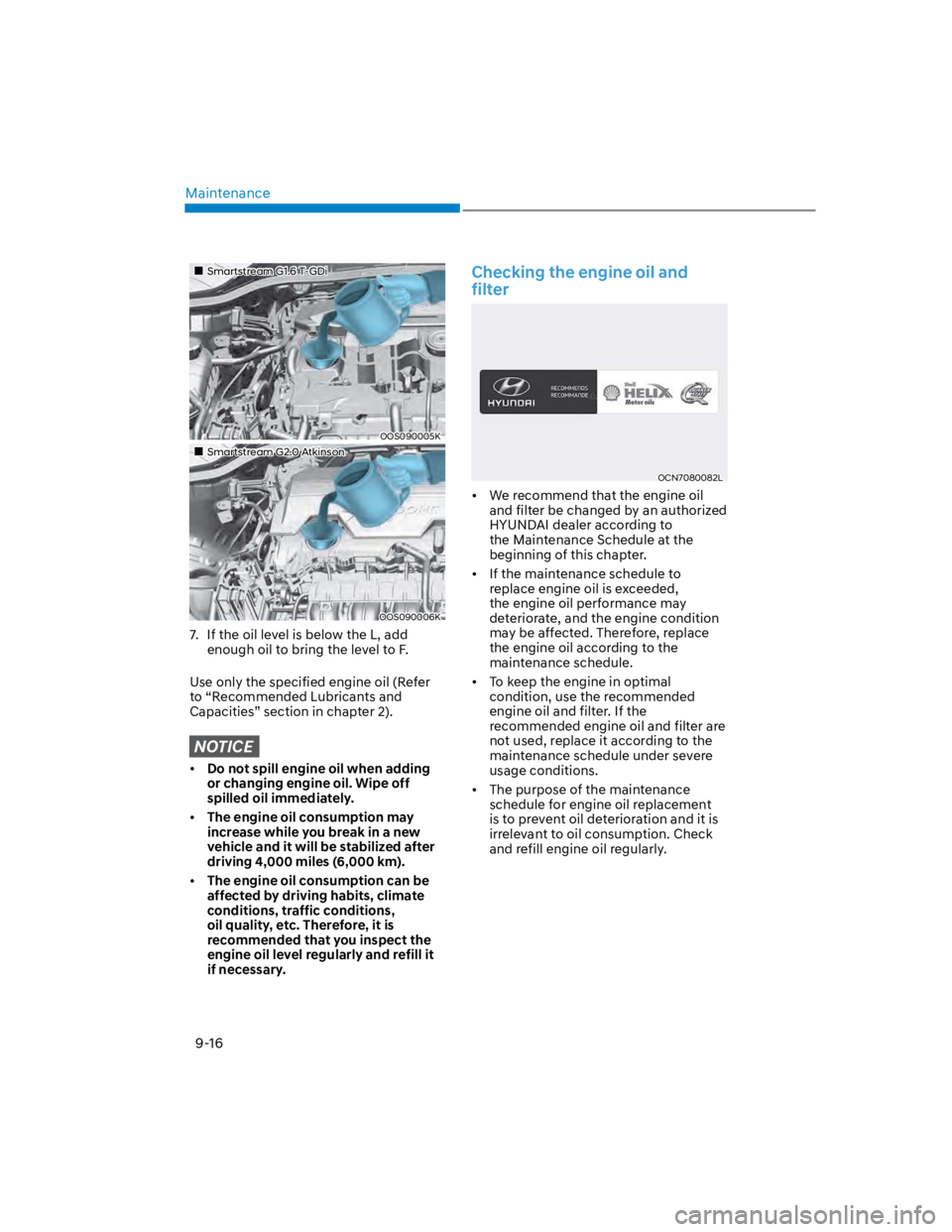
Maintenance
9-16
Smartstream G1.6 T-GDi
OOS090005K
Smartstream G2.0 Atkinson
OOS090006K
7. If the oil level is below the L, add
enough oil to bring the level to F.
Use only the specified engine oil (Refer
to “Recommended Lubricants and
Capacities” section in chapter 2).
NOTICE
Do not spill engine oil when adding
or changing engine oil. Wipe off
spilled oil immediately.
The engine oil consumption may
increase while you break in a new
vehicle and it will be stabilized after
driving 4,000 miles (6,000 km).
The engine oil consumption can be
affected by driving habits, climate
conditions, traffic conditions,
oil quality, etc. Therefore, it is
recommended that you inspect the
engine oil level regularly and refill it
if necessary.
Checking the engine oil and
filter
OCN7080082L
We recommend that the engine oil
and filter be changed by an authorized
HYUNDAI dealer according to
the Maintenance Schedule at the
beginning of this chapter.
If the maintenance schedule to
replace engine oil is exceeded,
the engine oil performance may
deteriorate, and the engine condition
may be affected. Therefore, replace
the engine oil according to the
maintenance schedule.
To keep the engine in optimal
condition, use the recommended
engine oil and filter. If the
recommended engine oil and filter are
not used, replace it according to the
maintenance schedule under severe
usage conditions.
The purpose of the maintenance
schedule for engine oil replacement
is to prevent oil deterioration and it is
irrelevant to oil consumption. Check
and refill engine oil regularly.
Page 506 of 579
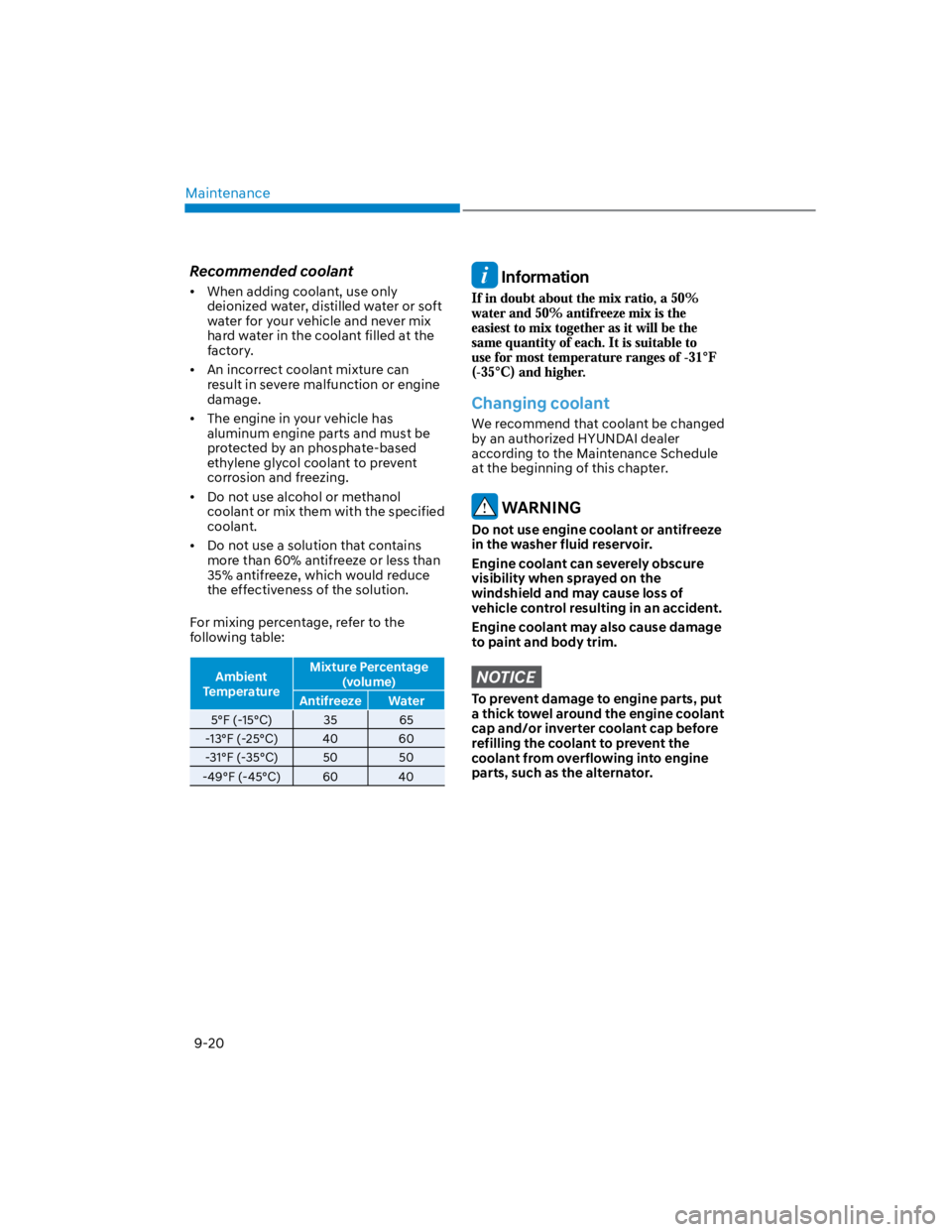
Maintenance
9-20
Recommended coolant
When adding coolant, use only
deionized water, distilled water or soft
water for your vehicle and never mix
hard water in the coolant filled at the
factory.
An incorrect coolant mixture can
result in severe malfunction or engine
damage.
The engine in your vehicle has
aluminum engine parts and must be
protected by an phosphate-based
ethylene glycol coolant to prevent
corrosion and freezing.
Do not use alcohol or methanol
coolant or mix them with the specified
coolant.
Do not use a solution that contains
more than 60% antifreeze or less than
35% antifreeze, which would reduce
the effectiveness of the solution.
For mixing percentage, refer to the
following table:
Ambient
Temperature
Mixture Percentage
(volume)
Antifreeze Water
5°F (-15°C) 35 65
-13°F (-25°C) 40 60
-31°F (-35°C) 50 50
-49°F (-45°C) 60 40
Information
Changing coolant
We recommend that coolant be changed
by an authorized HYUNDAI dealer
according to the Maintenance Schedule
at the beginning of this chapter.
WARNING
Do not use engine coolant or antifreeze
in the washer fluid reservoir.
Engine coolant can severely obscure
visibility when sprayed on the
windshield and may cause loss of
vehicle control resulting in an accident.
Engine coolant may also cause damage
to paint and body trim.
NOTICE
To prevent damage to engine parts, put
a thick towel around the engine coolant
cap and/or inverter coolant cap before
refilling the coolant to prevent the
coolant from overflowing into engine
parts, such as the alternator.
Page 510 of 579
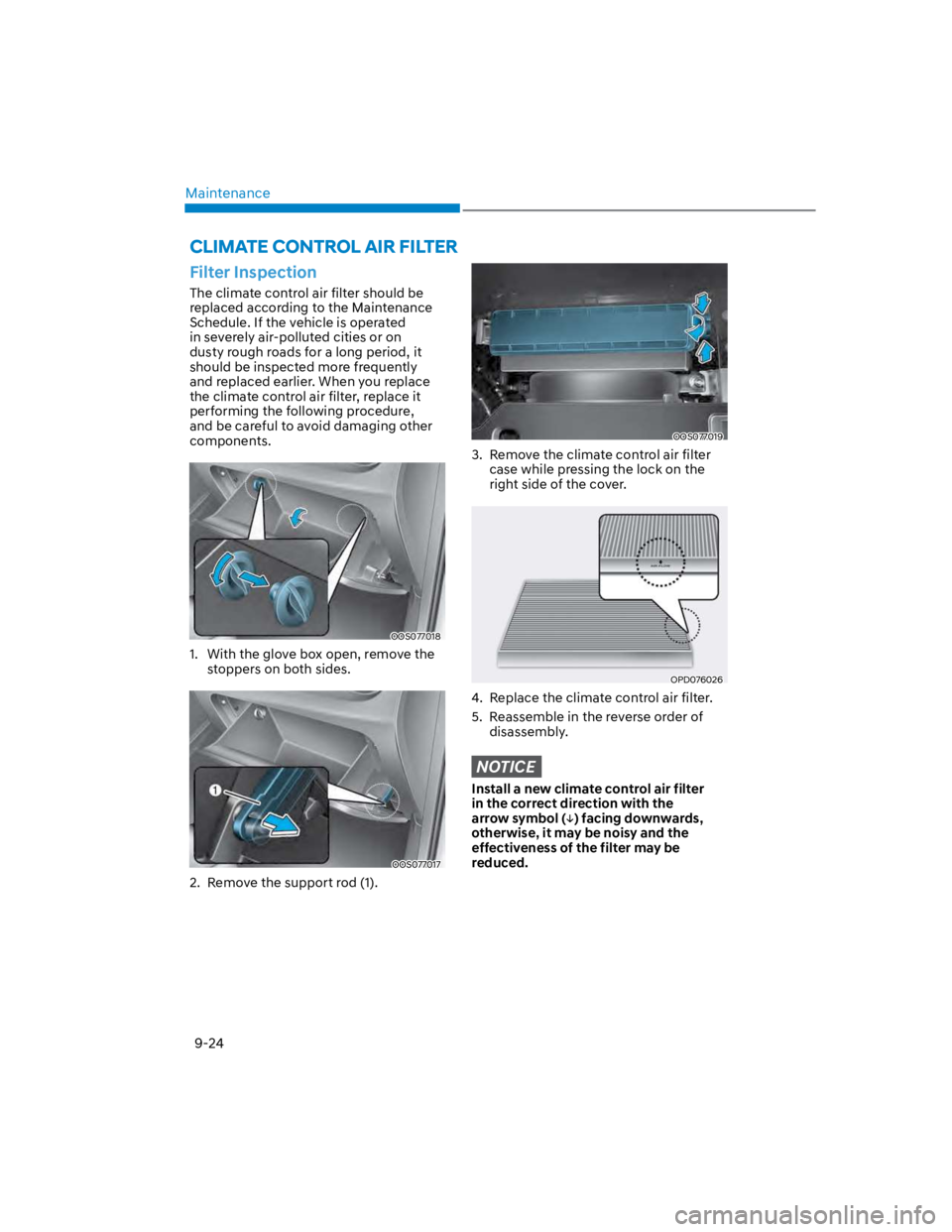
Maintenance
9-24
CLIMATE CONTROL AIR FILTER
Filter Inspection
The climate control air filter should be
replaced according to the Maintenance
Schedule. If the vehicle is operated
in severely air-polluted cities or on
dusty rough roads for a long period, it
should be inspected more frequently
and replaced earlier. When you replace
the climate control air filter, replace it
performing the following procedure,
and be careful to avoid damaging other
components.
OOS077018
1. With the glove box open, remove the
stoppers on both sides.
OOS077017
2. Remove the support rod (1).
OOS077019
3. Remove the climate control air filter
case while pressing the lock on the
right side of the cover.
OPD076026
4. Replace the climate control air filter.
5. Reassemble in the reverse order of
disassembly.
NOTICE
Install a new climate control air filter
in the correct direction with the
arrow symbol () facing downwards,
otherwise, it may be noisy and the
effectiveness of the filter may be
reduced.
Page 521 of 579
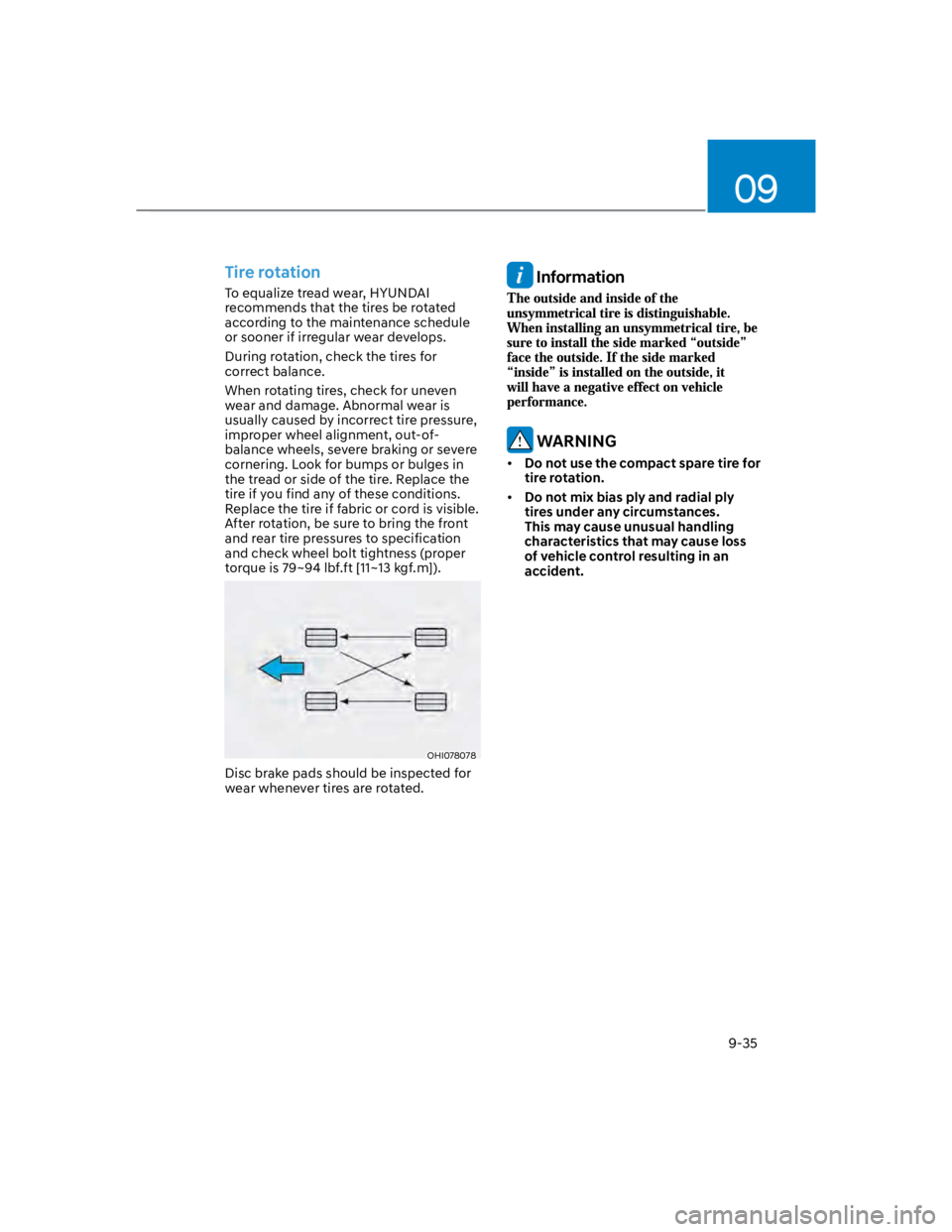
09
9-35
Tire rotation
To equalize tread wear, HYUNDAI
recommends that the tires be rotated
according to the maintenance schedule
or sooner if irregular wear develops.
During rotation, check the tires for
correct balance.
When rotating tires, check for uneven
wear and damage. Abnormal wear is
usually caused by incorrect tire pressure,
improper wheel alignment, out-of-
balance wheels, severe braking or severe
cornering. Look for bumps or bulges in
the tread or side of the tire. Replace the
tire if you find any of these conditions.
Replace the tire if fabric or cord is visible.
After rotation, be sure to bring the front
and rear tire pressures to specification
and check wheel bolt tightness (proper
torque is 79~94 lbf.ft [11~13 kgf.m]).
OHI078078
Disc brake pads should be inspected for
wear whenever tires are rotated.
Information
WARNING
Do not use the compact spare tire for
tire rotation.
Do not mix bias ply and radial ply
tires under any circumstances.
This may cause unusual handling
characteristics that may cause loss
of vehicle control resulting in an
accident.
Page 563 of 579
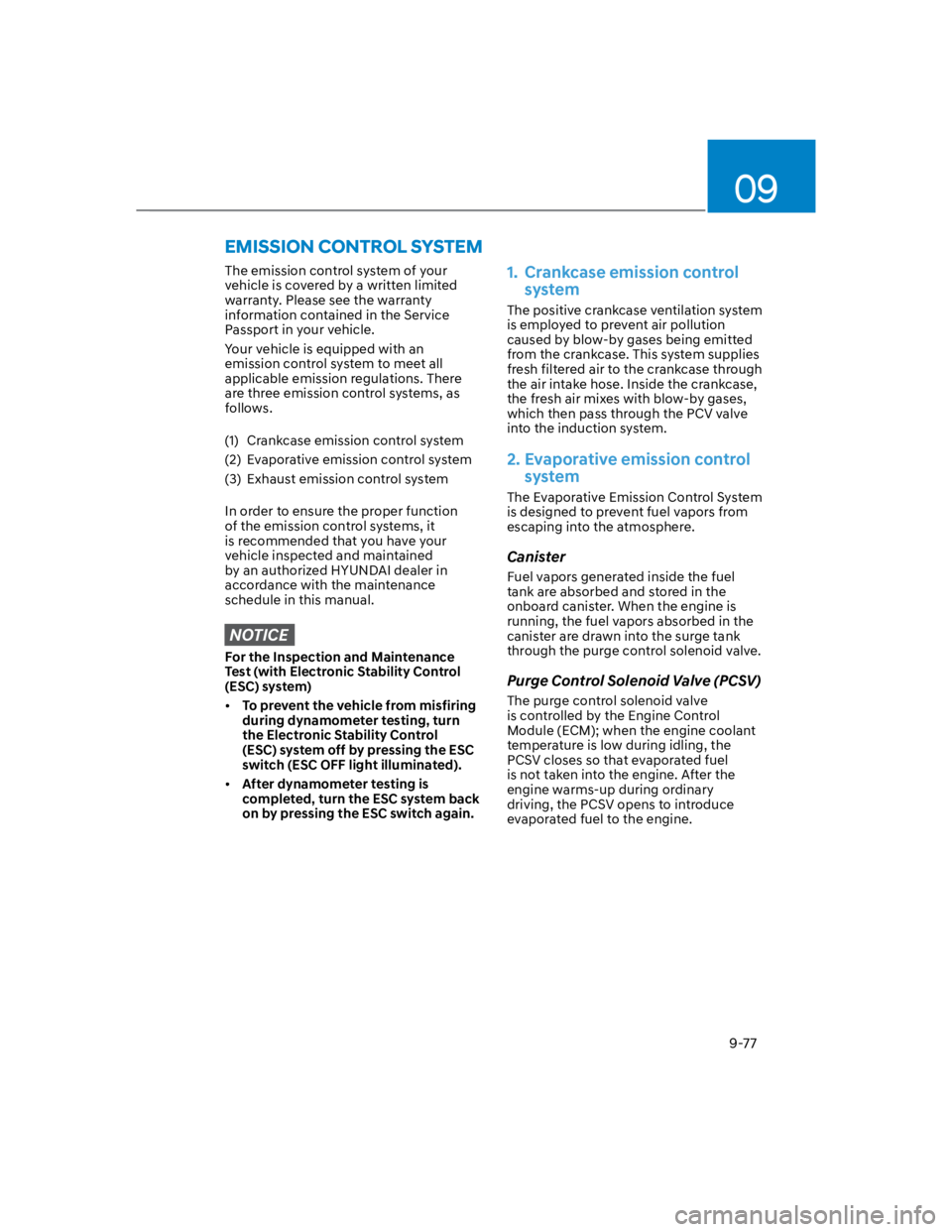
09
9-77
The emission control system of your
vehicle is covered by a written limited
warranty. Please see the warranty
information contained in the Service
Passport in your vehicle.
Your vehicle is equipped with an
emission control system to meet all
applicable emission regulations. There
are three emission control systems, as
follows.
(1) Crankcase emission control system
(2) Evaporative emission control system
(3) Exhaust emission control system
In order to ensure the proper function
of the emission control systems, it
is recommended that you have your
vehicle inspected and maintained
by an authorized HYUNDAI dealer in
accordance with the maintenance
schedule in this manual.
NOTICE
For the Inspection and Maintenance
Test (with Electronic Stability Control
(ESC) system)
To prevent the vehicle from misfiring
during dynamometer testing, turn
the Electronic Stability Control
(ESC) system off by pressing the ESC
switch (ESC OFF light illuminated).
After dynamometer testing is
completed, turn the ESC system back
on by pressing the ESC switch again.
1. Crankcase emission control
system
The positive crankcase ventilation system
is employed to prevent air pollution
caused by blow-by gases being emitted
from the crankcase. This system supplies
fresh filtered air to the crankcase through
the air intake hose. Inside the crankcase,
the fresh air mixes with blow-by gases,
which then pass through the PCV valve
into the induction system.
2. Evaporative emission control
system
The Evaporative Emission Control System
is designed to prevent fuel vapors from
escaping into the atmosphere.
Canister
Fuel vapors generated inside the fuel
tank are absorbed and stored in the
onboard canister. When the engine is
running, the fuel vapors absorbed in the
canister are drawn into the surge tank
through the purge control solenoid valve.
Purge Control Solenoid Valve (PCSV)
The purge control solenoid valve
is controlled by the Engine Control
Module (ECM); when the engine coolant
temperature is low during idling, the
PCSV closes so that evaporated fuel
is not taken into the engine. After the
engine warms-up during ordinary
driving, the PCSV opens to introduce
evaporated fuel to the engine.
EMISSION CONTROL SYSTEM
Page 571 of 579
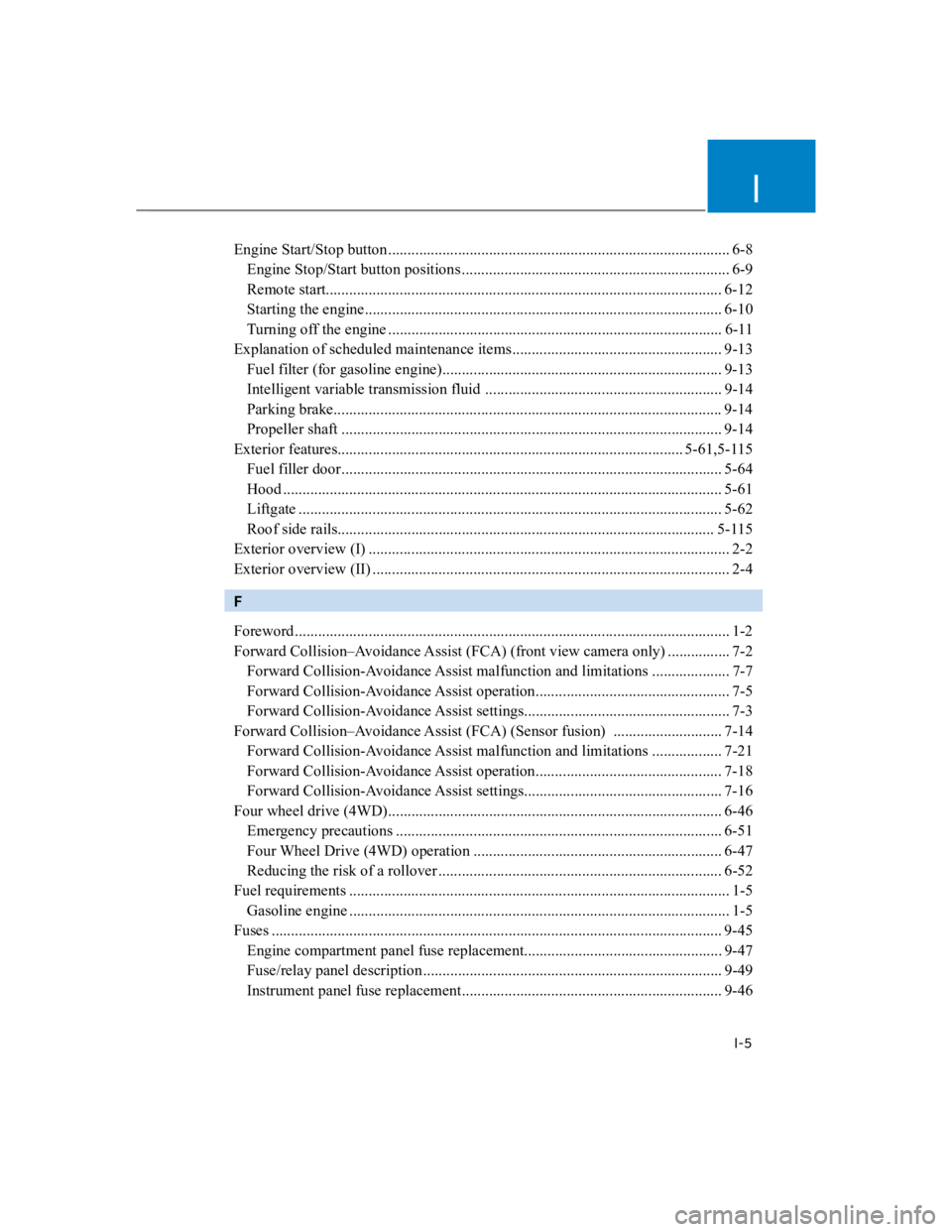
I
I-5
Engine Start/Stop button........................................................................................ 6-8
Engine Stop/Start button positions ..................................................................... 6-9
Remote start...................................................................................................... 6-12
Starting the engine............................................................................................ 6-10
Turning off the engine ...................................................................................... 6-11
Explanation of scheduled maintenance items ...................................................... 9-13
Fuel filter (for gasoline engine)........................................................................ 9-13
Intelligent variable transmission fluid ............................................................. 9-14
Parking brake.................................................................................................... 9-14
Propeller shaft .................................................................................................. 9-14
Exterior features......................................................................................... 5-61,5-115
Fuel filler door.................................................................................................. 5-64
Hood ................................................................................................................. 5-61
Liftgate ............................................................................................................. 5-62
Roof side rails................................................................................................. 5-115
Exterior overview (I) ............................................................................................. 2-2
Exterior overview (II) ............................................................................................ 2-4
F
Foreword................................................................................................................ 1-2
Forward Collision–Avoidance Assist (FCA) (front view camera only) ................ 7-2
Forward Collision-Avoidance Assist malfunction and limitations .................... 7-7
Forward Collision-Avoidance Assist operation.................................................. 7-5
Forward Collision-Avoidance Assist settings..................................................... 7-3
Forward Collision–Avoidance Assist (FCA) (Sensor fusion) ............................ 7-14
Forward Collision-Avoidance Assist malfunction and limitations .................. 7-21
Forward Collision-Avoidance Assist operation................................................ 7-18
Forward Collision-Avoidance Assist settings................................................... 7-16
Four wheel drive (4WD)...................................................................................... 6-46
Emergency precautions .................................................................................... 6-51
Four Wheel Drive (4WD) operation ................................................................ 6-47
Reducing the risk of a rollover ......................................................................... 6-52
Fuel requirements .................................................................................................. 1-5
Gasoline engine .................................................................................................. 1-5
Fuses .................................................................................................................... 9-45
Engine compartment panel fuse replacement................................................... 9-47
Fuse/relay panel description............................................................................. 9-49
Instrument panel fuse replacement................................................................... 9-46
Page 575 of 579
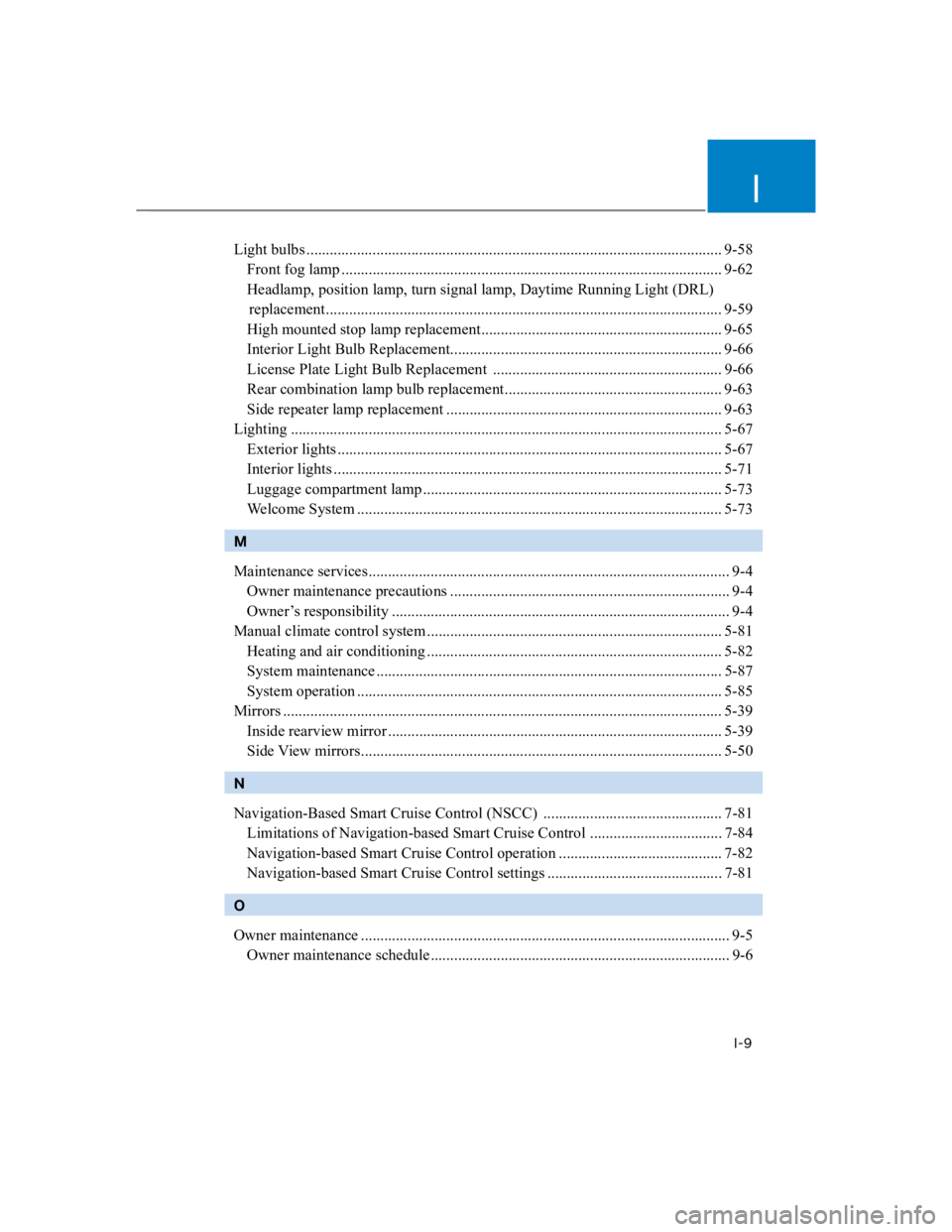
I
I-9
Light bulbs ........................................................................................................... 9-58
Front fog lamp .................................................................................................. 9-62
Headlamp, position lamp, turn signal lamp, Daytime Running Light (DRL)
replacement ...................................................................................................... 9-59
High mounted stop lamp replacement.............................................................. 9-65
Interior Light Bulb Replacement...................................................................... 9-66
License Plate Light Bulb Replacement ........................................................... 9-66
Rear combination lamp bulb replacement........................................................ 9-63
Side repeater lamp replacement ....................................................................... 9-63
Lighting ............................................................................................................... 5-67
Exterior lights ................................................................................................... 5-67
Interior lights .................................................................................................... 5-71
Luggage compartment lamp ............................................................................. 5-73
Welcome System .............................................................................................. 5-73
M
Maintenance services............................................................................................. 9-4
Owner maintenance precautions ........................................................................ 9-4
Owner’s responsibility ....................................................................................... 9-4
Manual climate control system ............................................................................ 5-81
Heating and air conditioning ............................................................................ 5-82
System maintenance ......................................................................................... 5-87
System operation .............................................................................................. 5-85
Mirrors ................................................................................................................. 5-39
Inside rearview mirror ...................................................................................... 5-39
Side View mirrors............................................................................................. 5-50
N
Navigation-Based Smart Cruise Control (NSCC) .............................................. 7-81
Limitations of Navigation-based Smart Cruise Control .................................. 7-84
Navigation-based Smart Cruise Control operation .......................................... 7-82
Navigation-based Smart Cruise Control settings ............................................. 7-81
O
Owner maintenance ............................................................................................... 9-5
Owner maintenance schedule ............................................................................. 9-6
Page 576 of 579
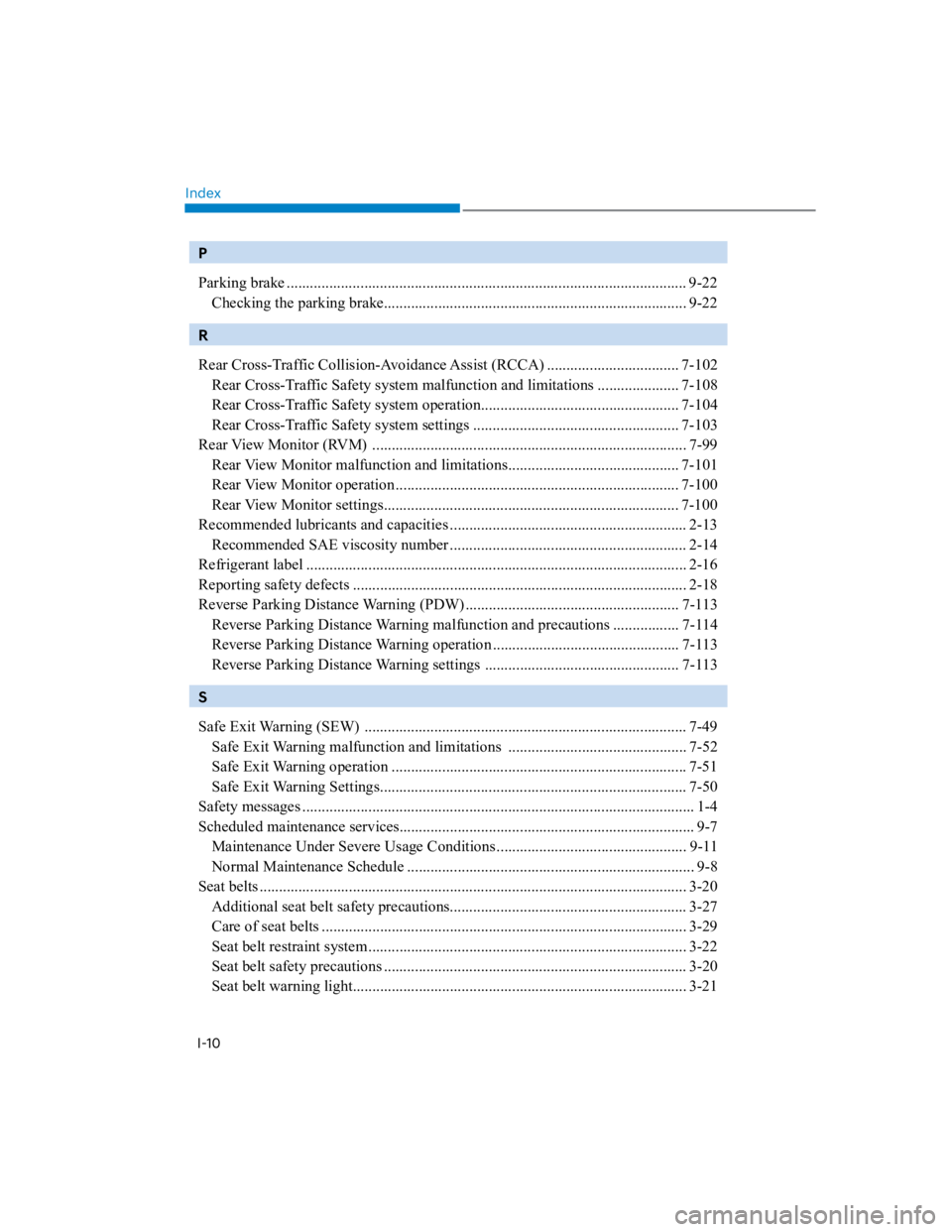
Index
I-10
P
Parking brake ....................................................................................................... 9-22
Checking the parking brake.............................................................................. 9-22
R
Rear Cross-Traffic Collision-Avoidance Assist (RCCA) .................................. 7-102
Rear Cross-Traffic Safety system malfunction and limitations ..................... 7-108
Rear Cross-Traffic Safety system operation................................................... 7-104
Rear Cross-Traffic Safety system settings ..................................................... 7-103
Rear View Monitor (RVM) ................................................................................. 7-99
Rear View Monitor malfunction and limitations............................................ 7-101
Rear View Monitor operation ......................................................................... 7-100
Rear View Monitor settings............................................................................ 7-100
Recommended lubricants and capacities ............................................................. 2-13
Recommended SAE viscosity number ............................................................. 2-14
Refrigerant label .................................................................................................. 2-16
Reporting safety defects ...................................................................................... 2-18
Reverse Parking Distance Warning (PDW) ....................................................... 7-113
Reverse Parking Distance Warning malfunction and precautions ................. 7-114
Reverse Parking Distance Warning operation ................................................ 7-113
Reverse Parking Distance Warning settings .................................................. 7-113
S
Safe Exit Warning (SEW) ................................................................................... 7-49
Safe Exit Warning malfunction and limitations .............................................. 7-52
Safe Exit Warning operation ............................................................................ 7-51
Safe Exit Warning Settings............................................................................... 7-50
Safety messages ..................................................................................................... 1-4
Scheduled maintenance services............................................................................ 9-7
Maintenance Under Severe Usage Conditions ................................................. 9-11
Normal Maintenance Schedule .......................................................................... 9-8
Seat belts .............................................................................................................. 3-20
Additional seat belt safety precautions............................................................. 3-27
Care of seat belts .............................................................................................. 3-29
Seat belt restraint system .................................................................................. 3-22
Seat belt safety precautions .............................................................................. 3-20
Seat belt warning light...................................................................................... 3-21